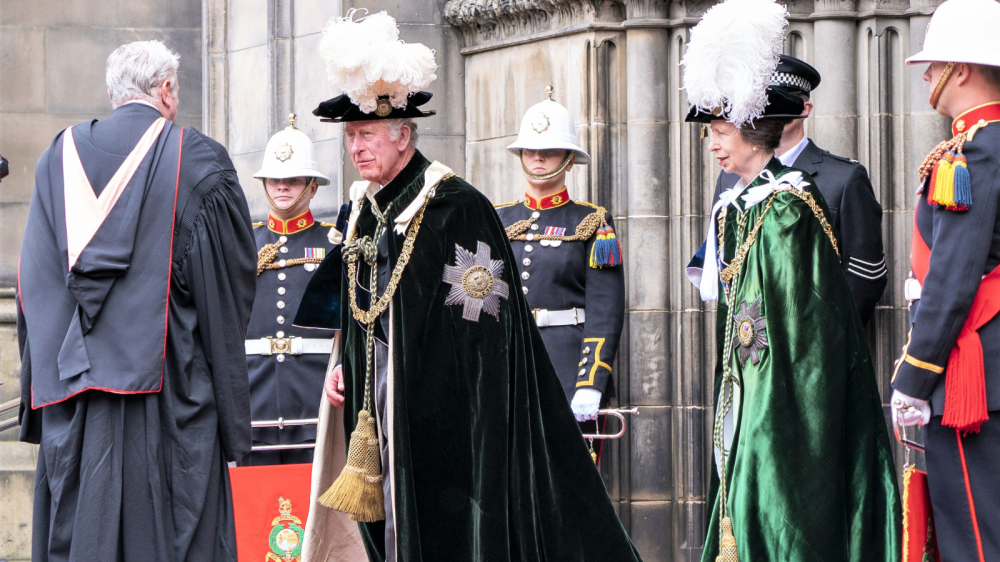The Order of the Thistle is the most senior order of chivalry in Scotland. It is the second highest order in Britain, preceded by the Order of the Garter.
But what is the history of this Scottish order? Who are the current members? Find out below where we have pulled together an in-depth guide.

History of the Order of the Thistle
The origin of the order’s creation is unknown. It may have its roots with James III, who reigned in Scotland 1488-1513 and was responsible for changes in Royal symbolism in Scotland, which included the adoption of the thistle as the royal Scottish flower.
James II (also known as James VII of Scotland) established the Order of the Thistle with a statutory basis under new rules in 1687, which was to reward individuals who supported the King’s political and religious views and aims in Scotland.
The order originally was comprised of the Scottish Sovereign and eight knights. However, Queen Anne increased the number of knights to 12, and in 1827 the number was raised to 16, the number it remains at today.
Who is appointed to the Order of the Thistle?
The British Monarch is the Sovereign of the order. Appointments are entirely their personal gift, in recognition of those who have held public office or have contributed significantly to national life, much like the Order of the Garter.

The Thistle’s Habit and Insignia
For the Order of the Thistle’s ceremonial occasions, Officers and Knights wear elaborate vestments and accoutrements, which include:
The mantle: a green robe worn over their suits or military uniforms. The mantle is lined with white taffeta, which is tied with green and gold tassels. On the left shoulder of the mantle, the star of the Order is seen.
The hat: made of black velvet and is plumed with white feathers with a heron’s top in the middle.
The collar: made of gold and depicts thistles and sprigs of rue. It is worn over the mantle.
The St Andrew: worn suspended from the collar. It comprises a gold enamelled depiction of St Andrew, who is seen wearing a green gown and purple coat, holding a white saltire. Gold rays of a glory are shown from St Andrew’s head.
However, on certain collar days dictated by the Sovereign, members of the Thistle attending events may wear the order’s collar over their military uniform or formal wear. These events include Trooping the Colour. They will then substitute the riband of another order to which they belong, with the Thistle being represented by the collar.
The Order of the Thistle Service
Every other year, members of the order take part in a grand procession to the Chapel of the Order of the Thistle in Edinburgh, for the Order of the Thistle Service.
The Knights and Ladies are seen to be dressed in their striking green velvet robes, glistening insignia and white-plumed hats.
Members of the Order meet at the Thistle Chapel in St Giles’ Cathedral, where any new members are installed by the Monarch. There is then a procession which begins in the Signet Library in Edinburgh Town Centre, while in Parliament Square the collection The Guard of Honour with the Colours (flags) of the Royal Company takes place, accompanied by the Band of the Royal Regiment of Scotland.
@crownchronicles A peel inside the Thistle Chapel in #stgilescathedral #Edinburgh #orderofthethistle #royalfamily #royaltok #crownchronicles #royal #history #architecture ♬ To Edinburgh – Ian Post
The chapel was updated on the orders of Edward VII in 1910, with ornately carved wooden stalls.
The Sovereign and the Knights, accompanied by the Chancellor, Dean and Secretary of the Thistle, then process into the Chapel of the Order of the Thistle, where the Monarch installs the new Knights and Ladies. The procession then continues to the Cathedral.
Afterwards, there is a short reception in the Signet Library, and a lunch at the Palace of Holyroodhouse.
Current Members and Officers
The Sovereign (King Charles III) is head of the Order.
Extra Knights and Ladies:
– The Princess Royal
– The Prince of Wales (also known as The Duke of Rothesay when in Scotland)
Knights and Ladies
– The Earl of Elgin and Kincardine
– The Earl of Airlie
– The Lord Mackay of Clashfern
– The Lord Wilson of Tillyorn
– The Lord Steel of Aikwood
– The Lord Robertson of Port Ellen
– The Lord Cullen of Whitekird
– The Lord Hope of Craighead
– The Lord Patel
– The Lord Smith of Kelvin
– The Duke of Buccleuch and Queensberry
– Sir Ian Wood
– Lady Elish Angiolini
– Sir George Reid
As of May 2023, there are two vacancies.
Officers:
– Chancellor: The Earl of Airlie
– Dean: The Reverend David Fergusson
– Secretary Elizabeth Roads
– Lyon King of Arms: Joseph Morrow
– Gentleman Usher of the Green Rod: Rear Admiral Christopher Hope Layman









